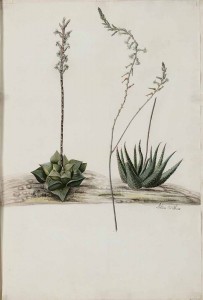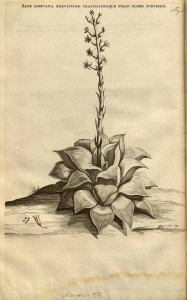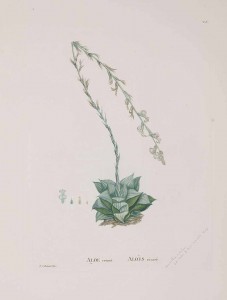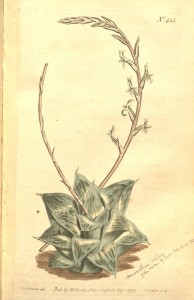32. Haworthia retusa (L.) Duval, Pl.Succ.Hort.Alenc. :7(1809). Haw., Syn.Pl.Succ. :95(1812). Bayer :150(1976). Bayer in Excelsa 8:46(1979). Bayer :53(1982). pp Scott :112(1986). Aloe retusa L. Sp.Pl. :322(1753). Haw., Trans.Linn.Soc. 7:9(1804). Type: icon, 2:t6 Commelin, Hort.Amstel.(1701): H. foucheii V.Poelln., Succulenta 22:28(1940). Type: Cape, Riversdale district, Grootvlei, Fouche. Not preserved. Neotype (designated here): CAPE-3421(Riversdale): Near Riversdale, Grootvlei (-AB), Dekenah 212 (NBG): H. retusa var. multilineata Smith, JS.Afr.Bot. 12:3(1946). H. multilineata (Smith) Scott :135(1985). Type: CAPE-3421(Riversdale): 3km N. Riversdale, J. Dekenah 83 in Smith 5383 (NBG): H. retusa var. solitaria Smith, JS.Afr.Bot. 12:5(1946). H. solitaria (Smith) Scott, Aloe 11:37(1973). Type (designated here): CAPE-3421(Riversdale): along Corrente River, 10km N Riversdale, Dekenah 5 in Smith 5373 (NBG): H. retusa var. densiflora Smith, JS.Afr.Bot. 12:7(1946). Type: CAPE-3421(Riversdale): Riversdale district, Venter 106 in Smith 5056 (NBG): H. geraldii Scott, JS.Afr.Bot. 31:123(1965). Scott, Aloe 11:22(1973). Scott :132(1985). Type: CAPE-3421(Riversdale): 5km east of Riversdale, Scott 72 (PRE).3
retusa: with leaf-tips bent back thumb-like.
Rosette stemless, slowly or seldom proliferous, to 12cm φ. Leaves 10-15, turgid, rigid, with pronounced retused end-area, pointed tips, variously lined and windowed. Without surface spination and usually without spination on margins and keel. Colours brownish or green and seldom purpling. Inflorescence simple, robust, to 30cm. Flowers compacted on inflorescence, white with greenish-brown veins.
1982 – H. retusa is very closely associated with H. turgida, and an eventual re-evaluation of this association could lead to a total upheaval of species concepts in this group of haworthias. H. retusa is taken to be an assemblage of forms in the Heidelberg and Riversdale areas, with clearly defined end areas, and points, to the leaves. The various forms may or may not be proliferous, for example the var. solitaria was largely solitary, whereas the form described as H. geraldii is very proliferous. The forms vary in cultivation and both dark and light green forms may occur. The darker forms may have some relationship to H. magnifica, and the light forms to H. turgida. The species is not well known in the area between Heidelberg and the Breede River and hence it is not known whether or not H. mutica and H. retusa intergrade. H. mutica may simply be a blunt‑leaved form of H. retusa. The var. dekenahii from Albertinia is now thought to be represented by several populations in which plants have leaves very silver‑spotted ‑ a phenomenon which occurs in H. turgida too. This variety may eventually be shown to link H. retusa and H. pygmaea. There is still an apparent break in the distribution of these two species between Mossel Bay and Albertinia. The var. acuminata tends to be darker green and the leaves are very acuminate. It occurs in the south‑east of the distribution range of the species and may also be expected in the area southwest of Albertinia ‑ still unexplored.
1999 – This revised treatment fulfils the predictions of 1982 amid the realisation that the views expressed there are correct, but stopping short of uniting H. retusa with H. turgida. H. longebracteata Smith is now here regarded as a variant of that ubiquitous species and strictly H. geraldii Scott should be treated similarly. However, the key issue is that H. retusa, as perceived here, is the robust, generally solitary forms which occur only in the Riversdale area. Scott’s treatment is rather fortuitous in that he typifies the name in the same way, but applies it to the smaller clump-forming elements which comprise H turgida. This is evident from his synonymy but totally compromised in his discussion where:- 1. he says it is restricted to one locality at Riversdale and two to three in the Little Karoo, and 2. the distribution map where localities at Little Brak and at Tradouw pass seem to be indicated. Breuer and Metzing’s argument for the creation of an epitype, and also their choice, is also unfortunate. The Commelin illustration could hardly be more distinctive and apart from Col Scott who muddled H. retusa and H. turgida, there has never ever been any sign of doubt about its application. Furthermore, they select a specimen from the source of H. fouche. The Commelin, illustration depicts the acute leaf-tips of the species very well and there is little chance of confusion with H. mutica
In the species concept for the genus, co-occurrence and consequent interaction, or lack thereof, are criteria for recognising species. In the field it has become obvious that the interaction between species revolves around H. turgida as a main role-player and not H. retusa. There is no interaction between the latter two named elements as they do not co-occur. The three species recognised by Scott viz. geraldii, fouchei and multilineata give a very good impression of the variation of this one species in the Riversdale area. The var. solitaria may represent interaction with H. magnifica, and the vars. acuminata and dekenahii are both transferred to that species. H. dekenahii var. argenteo-maculosa is treated as a variety of H. pygmaea. The problem plants around Heidelberg are associated with H. mutica.
Distribution: 3421 (Riversdale): 8km W. Riversdale (-AA), Smith 5443 (NBG); Along Corrente River, 10km NW. Riversdale (-AA), Dekenah 5 in Smith 5373 (NBG), Dekenah in KG305/71 (NBG); 4km N. Riversadel (-AA), Smith 5493 (NBG); SW. Riversdale (-AA), Smith 5387 (NBG); Near Riversdale, Grootvlei (-AB), Dekenah 212 (NBG), Smith 4955 (NBG), Fourcade 263 (NBG), Bayer in KG627/69 (NBG), Bohnen 9058 (NBG); Blinkbonnie (-AB), Smith 6086 (NBG), Venter in KG 156/71; Zeekoegat (-AB), Smith 6089 (NBG); Ferguson Drive (-AB), Smith 5380 (NBG, PRE); 3km N. Riversdale (-AB), J. Dekenah 83 in Smith 5383 (NBG), Smith 5374, 5488 (NBG, PRE), Smith 6796 (NBG); 5km E. Riversdale (-AB), Scott 72 (PRE), Smith 5377 (NBG); Vet River Road (-AB), Smith 5383, 5387 (PRE); 14km E. Riversdale (-AB), Smith 5749, 7320 (NBG); Bolus 2868 (PRE); Commonage (-AB), Smith 5377 (PRE); Dekenah 11 (PRE); Riversdale (-AB), Fouche in PRE 34869; 3km E., Grootvlei (-AB), J. Scott 1778 (PRE); 3km E. (-AB), J. Scott 93 (PRE);
Inadequately located: Riversdale district, Venter 106 in Smith 5056, Smith 3432, 3850, 3919, 3962, 5043, 5056, 5599 (NBG), Bolus 11390 (BOL), Helm in NBG1746/32, Malherbe in NBG399/40, ex hort, Wilman in PRE 34904.


Haworthia retusa JDV93/57 east of Riversdale. Some forms are reminiscent of H. magnifica. 
Haworthia retusa JDV89/26 south of Riversdale. Others are enormous and range from brown to yellow. 
Haworthia retusa JDV92/122 southeast of Riversdale. A motly assemblage where some are conspicuously veined. 
Haworthia retusa JDV92/122 southeast of Riversdale. Some clones remain very compact. 
Haworthia retusa JDV92/122 southeast of Riversdale. Despite the size there is an attempt at concealment. 
Haworthia retusa JDV92/69 southeast of Riversdale. A cultivar referred to as ‘Jolly Green Giant’ probably originated in this area. 
Haworthia retusa JDV87/5 east of Riversdale. The well known fa. geraldii, which is not accepted in this treatement although the name could be retained for practical and historical reasons. 
Haworthia retusa JDV87/5 east of Riversdale. This form is only known from one small site where it forms massive clusters. 
Haworthia retusa JDV92/125 east of Riversdale. This is the fa. fouchei, occuring a stone’s throw from geraldii but also not upheld for the same reasons. 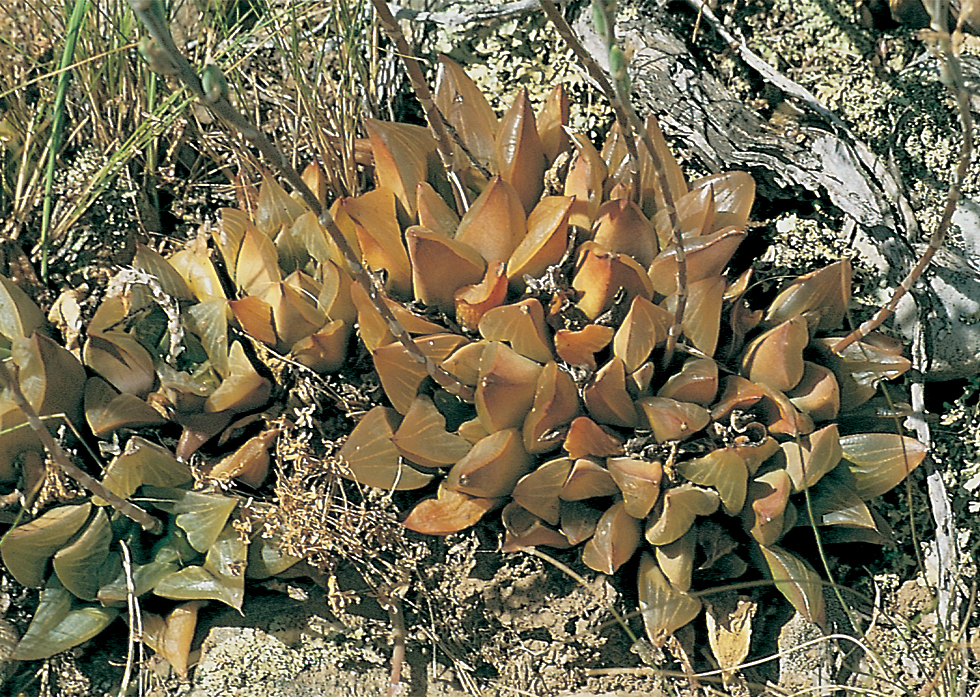
Haworthia retusa JDV92/125 east of Riversdale. As with H. magnifica var. magnifica, there are two populations of this H. retusa variety on the same ridge. This is also the fa. fouchei, recognized by its erect leabes. 
Haworthia retusa JDV92/125 east of Riversdale. The leaves are more erect and there is continuity down the Kafferkuilsrivier with H. turgida.
[ed. Bayer subsequently resurrected some of the varieties.]
H. retusa (Linné) Duval (Pl. Succ. Horto Alencon., 7, 1809). Type: [lecto — icono]: Commelin, Horti Med. Amstelod. 2: 11, t. 6, 1701. — Distr: RSA (Western Cape); Fynbos vegetation.
≡ Aloe retusa Linné (1753) ≡ Catevala retusa (Linné) Medikus (1786) ≡ Apicra retusa (Linné) Willdenow (1811) ( incorrect name, ICN Art. 11.4).
H. retusa var. longibracteata (G. G. Smith) M. B. Bayer (Haworthia Update Vol. 7, Part 4, 36, 2012). Type: RSA, Western Cape ( Dekenah 18 in Smith 5378 [NBG, PRE]). — Distr: RSA (Western Cape). I: Scott ( 1985: 127, as H. longibracteata).
≡ Haworthia longibracteata G. G. Smith (1945) ≡ Haworthia retusa fa. longibracteata (G. G. Smith) Pilbeam (1983) ≡ Haworthia turgida var. longibracteata (G. G. Smith) M. B. Bayer ( 1999).
Differs from var. retusa: L erect to suberect, ovate-lanceolate.
H. retusa var. nigra (M. B. Bayer) M. B. Bayer (Haworthia Update Vol. 7, Part 4, 36, 2012). Type: RSA, Western Cape ( Smith 5753 [NBG]). — Lit: Bayer ( 2004a); Bayer ( 2004c); Bayer ( 2005); all as H. mutica var. Distr: RSA (Western Cape: Heidelberg area).
≡ Haworthia mutica var. nigra M. B. Bayer ( 1999) ≡ Haworthia silviae var. nigra (M. B. Bayer) M. Hayashi (2000); incl. Haworthia chromutica M. Hayashi (2000) ( nom. inval., ICN Art. 39.1, 40.1); incl. Haworthia quimutica Breuer ( 2011) ( nom. inval., ICN Art. 38.1a).
Differs from var. retusa: Ros more proliferous; L greener and more translucent.
H. retusa var. retusa — Distr: RSA (Western Cape: Riversdale). I: Bayer ( 1982: Fig. 33a).
Incl. Haworthia fouchei Von Poellnitz (1940) ≡ Haworthia retusa fa. fouchei (Von Poellnitz) Pilbeam (1983) ≡ Haworthia retusa var. fouchei (Von Poellnitz) Breuer (2016); incl. Haworthia retusa var. densiflora G. G. Smith (1946); incl. Haworthia retusa var. multilineata G. G. Smith (1946) ≡ Haworthia retusa fa. multilineata (G. G. Smith) Pilbeam (1983) ≡ Haworthia multilineata (G. G. Smith) C. L. Scott (1985); incl. Haworthia retusa var. solitaria G. G. Smith (1946) ≡ Haworthia solitaria (G. G. Smith) C. L. Scott (1973); incl. Haworthia geraldii C. L. Scott (1965) ≡ Haworthia retusa fa. geraldii (C. L. Scott) Pilbeam (1983) ( nom. inval., ICN Art. 41.5); incl. Haworthia retusa var. quimutica Hayashi (2001); incl. Haworthia subretusa Breuer ( 2010) ( nom. inval., ICN Art. 36.1b, 38.1a).
Ros stemless, rarely slowly proliferating, to 12 cm ∅; L 10–15, turgid, rigid, with pronouncedly retuse end-areas, 8 × 2 cm, brownish or green and rarely with purplish hue, variously lined and windowed, surface and usually also margins and keel without spines or tubercles, tips pointed; Inf robust, to 30 cm; Fl 20–30, closely spaced, white with greenish-brown veins.
Possible hybridization with H. mirabilis is mentioned by Bayer ( 2012d).
H. retusa var. suberecta (Von Poellnitz) M. B. Bayer (Haworthia Update Vol. 7, Part 4, 36, 2012). Type [neo]: RSA, Western Cape ( Bayer s.n. in Karoo Garden 631/69 [NBG]). — Distr: RSA (Western Cape). I: Scott ( 1985: 126, as H. dekenahii).
≡ Haworthia turgida var. suberecta Von Poellnitz (1938) ≡ Haworthia turgida fa. suberecta (Von Poellnitz) Pilbeam (1983) ≡ Haworthia suberecta (Poellnitz) Breuer ( 2010); incl. Haworthia turgida var. subtuberculata Von Poellnitz (1938); incl. Haworthia turgida var. pallidifolia G. G. Smith (1946) ≡ Haworthia turgida fa. pallidifolia (G. G. Smith) Pilbeam (1983) ≡ Haworthia pallidifolia (G. G. Smith) M. Hayashi (2010) ≡ Haworthia suberecta var. pallidifolia (G. G. Smith) Breuer (2016); incl. Haworthia pseuda Breuer ( 2010) ( nom. inval., ICN Art. 36.1b, 38.1a); incl. Haworthia reflexa Breuer ( 2010) ( nom. inval., ICN Art. 36.1b, 38.1a); incl. Haworthia rodinii Breuer ( 2010) ( nom. inval., ICN Art. 36.1b, 38.1a).
Differs from var. retusa: L strongly mottled, tips slightly truncate and rounded.
H. retusa var. turgida (Haworth) M. B. Bayer (Haworthia Update Vol. 7, Part 4, 36, 2012). Type [neo]: RSA, Western Cape ( Bayer 2420 [NBG 132378]). — Distr: RSA (Western Cape). I: Bayer ( 1982: Fig. 40, as H. turgida).
≡ Haworthia turgida Haworth (1819) ≡ Aloe turgida (Haworth) Roemer & Schultes fil. (1829); incl. Haworthia laetevirens Haworth (1819) ≡ Aloe laetevirens (Haworth) Link (1822); incl. Haworthia caespitosa Von Poellnitz (1937) ≡ Haworthia turgida fa. caespitosa (Von Poellnitz) Pilbeam (1983); incl. Haworthia caespitosa fa. subplana Von Poellnitz (1938); incl. Haworthia caespitosa fa. subproliferans Von Poellnitz (1938).
Differs from var. turgida: Ros partially stemless, proliferous, 5–10 cm ∅; L 20–40, ovate-lanceolate, 4 × 1.2 cm, turgid, often as thick as broad, recurved or slightly retuse, margins and keel lightly spined.

